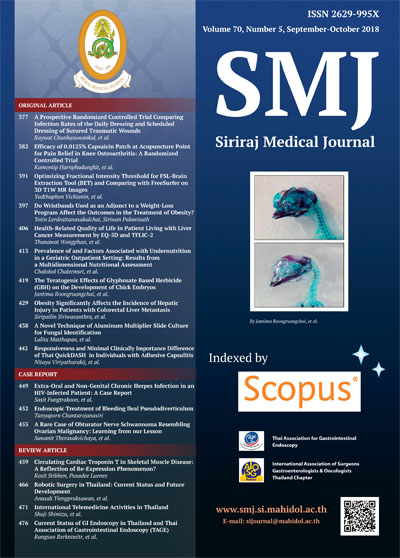Prevalence of and Factors Associated with Undernutrition in a Geriatric Outpatient Setting: Results from a Multidimensional Nutritional Assessment
Keywords:
Mini nutritional assessment; nutritional status; geriatric clinic; geriatric outpatients; undernutritionAbstract
Objective: To determine the prevalence of and factors associated with undernutrition in older patients in a geriatric
outpatient setting.
Methods: A cross-sectional study in people aged 65 years or older was conducted at a geriatric outpatient clinic in
Bangkok, Thailand. Nutritional status was assessed by Mini Nutritional Assessment (MNA) score. Demographic
data, activities of daily living, food frequency questionnaire (FFQ), anthropometric measurements, complete blood
count, and serum albumin were recorded in every subject. Body composition analysis was measured by bioelectrical
analysis (BIA) at the same visit.
Results: Three hundred and twenty-four adults (63% women) with a mean age of 77.5 years (SD 6.8 years) were
enrolled. Prevalence of undernutrition, at-risk of undernutrition, and well-nourished were 8.3%, 35.5%, and 56.2%,
respectively. In univariate logistic regression analysis, factors associated with increased risk of undernutrition
(defined by MNA <24) were dependency in carrying out instrumental activities of daily living (IADL) or basic
activities of daily living (BADL), dementia, depression, low education, cerebrovascular disease, polypharmacy,
female, multiple co-morbidities, and increasing age. In multivariate logistic regression analysis adjusted for age and
gender, depression, cerebrovascular disease, and dementia were significantly associated with risk of undernutrition.
Conclusion: Although older patients in our study had higher socioeconomic status than general population, the
prevalence of undernutrition in our geriatric clinic was high. Factors significantly associated with undernutrition in
our study were depression, cerebrovascular disease, and dementia. Early recognition and intervention are essential
for effective undernutrition prevention.
Downloads
Published
How to Cite
Issue
Section
License
Authors who publish with this journal agree to the following conditions:
Copyright Transfer
In submitting a manuscript, the authors acknowledge that the work will become the copyrighted property of Siriraj Medical Journal upon publication.
License
Articles are licensed under a Creative Commons Attribution-NonCommercial-NoDerivatives 4.0 International License (CC BY-NC-ND 4.0). This license allows for the sharing of the work for non-commercial purposes with proper attribution to the authors and the journal. However, it does not permit modifications or the creation of derivative works.
Sharing and Access
Authors are encouraged to share their article on their personal or institutional websites and through other non-commercial platforms. Doing so can increase readership and citations.











